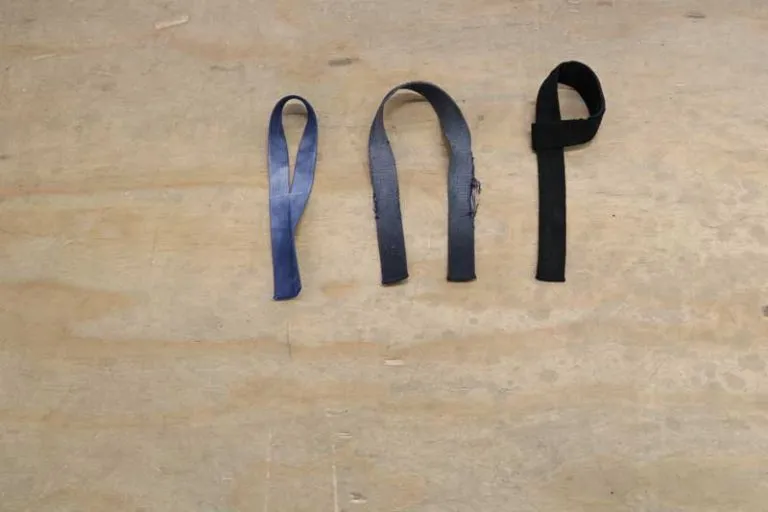Although Weightlifting and Powerlifting are a very small part of what we do at Arkitect Fitness, our team sport and general fitness clients always notice the special gear our strength athletes use, and often inquire about if it’s something they should invest in. While you technically don’t need any special apparel or equipment to get results, certain items can make a big difference in your training. We’ve already written about Weightlifting Shoes, so today we’re going to talk about another, somewhat controversial piece of gear: Lifting straps.
Straps are a short piece of fabric, leather, or webbing that wraps around your wrist, and then around a barbell, dumbbell, or pull-up bar, to help secure your grip. Do not confuse these with wrist wraps, which simply wrap around your wrist to give added support (much like a knee wrap or brace). The reason why straps can be controversial is because some people consider it “cheating” because a piece of fabric is supporting a great deal of the load, rather than your hand alone. It’s said a chain is only as strong as its weakest link, and that would apply to fitness as well. If your back has the strength to deadlift 500lbs, but you can only hold 400lbs, that’s a problem. But like all things in fitness (and life), whether or not you should use straps is dependent on the situation, individual, and application.
Types of Straps
There are two basic types of straps: The more common type is the style used by bodybuilders. These are a long piece of fabric with a loop at the end. The top end is looped through the bottom

creating a bigger loop for you to put your hand through. The second type, more commonly used by Weightlifters, is one piece of fabric with the ends stitched together. The type you should use is both personal preference, and what you’re using it for. Weightlifters use them mainly for the snatch and its variations, and the bodybuilding style of strap can be a little too tricky to get out of should you need to bail on a lift as it goes overhead. Bodybuilding straps tend to be a bit thinner, so they may be a more comfortable option if you’re wearing them for multiple exercises throughout a workout. Note that in pictured in the middle is an open ended strap. This is simply a strap that is not stitched at the end. They can be a little trickier to apply because they require you to pinch the ends together before wrapping around the bar.
How to use them
The first thing is to pull the strap snug against your wrist. After that you want to wrap the strap under and around the bar. Then firmly grip the bar, and you’re good to go. When you begin the lift the strap will cinch around your wrist, placing some of the tension on your arm, rather than your hand. It is recommended that you strap up your non-dominant hand first, so your dominant hand can help out, thus leaving your dominant hand to strap in by itself. It is important that the strap is taught around the wrist or else it will have little to no effect in helping you grip the bar. In the video below you get a front and back view of using your free hand to assist your non-dominant hand, as well as your dominant hand wrapping the strap by itself. Straps feel a bit awkward at first, and take a little bit of practice to put them on quickly and snugly, but they are very worth the effort of learning.
https://www.instagram.com/p/BSbf_Lel9CP
When to Use Them
- General Fitness Clientele
- Any time you are having trouble gripping (with the exception of grip specific exercises).
- We program a lot of landmine exercises, and since most of them have the athlete gripping the sleeve of the barbell (which is 2″ in diameter) rather than the shaft, this makes it difficult to hold on to.
- Another scenario would be ab exercises hanging from pull-up bar.
- Weightlifters
- Hang snatches
- Snatch or Clean Pulls
- Deadlifts
- Multi rep sets of snatches where you hold onto the bar between reps
- Powerlifters
- Multi-rep sets of deadlifts
- Accessory exercises
When Not to Use Them
- General Fitness Clientele
- Grip training exercises! If you’re supposed to be doing something like farmers carries, they are specifically designed to challenge your grip, so a strap would be inappropriate here.
- One rep max deadlifts. When you max, we’re looking for your limits, and that includes finding the weakest link. If that’s your grip, a strap will mask that. If we don’t think grip is an issue, occassionally we use straps in this situation.
- Weightlifters
- Cleans. There has been some debate about this, and recently using straps on cleans has become more popular, but in my opinion it simply puts too much pressure on the wrist. Check out the crazy video of Zach Krych (below) to see what can happen when you use straps on cleans.
- 1 rep max snatches. Again there is some debate about this, but I prefer not to have my athletes use straps on max effort snatches. We don’t use straps in competition, and I prefer to practice like you play.
- Powerlifters
- One rep max deadlifts. Again, there is debate in the community about this, but most Powerlifting federations do not allow the use of straps.
Where to get them
Below you’ll find some links to straps that our athletes like to wear as well as a tutorial on how to make your own. You can also find plenty of options on Amazon, and sometimes you can find them in your local sports retailer, although they’re usually overpriced and cheaply made.




